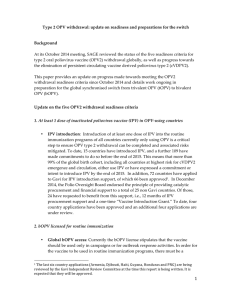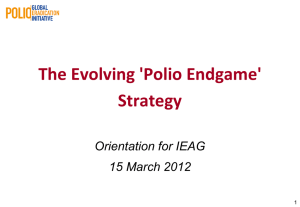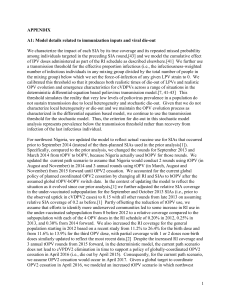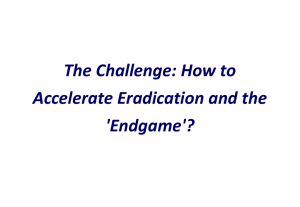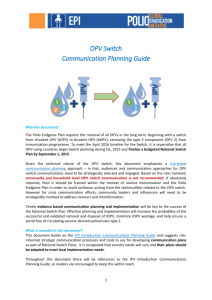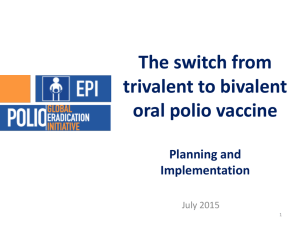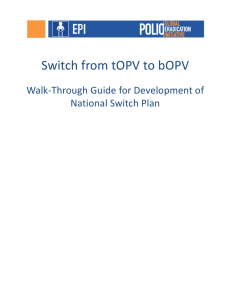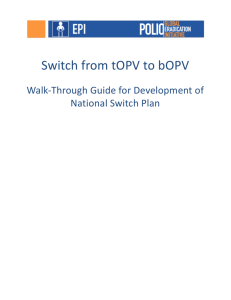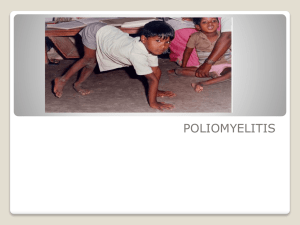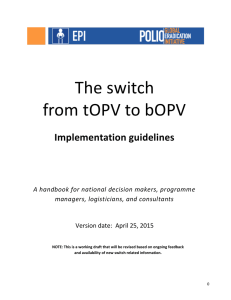Frequently Asked Questions – August 2015
advertisement
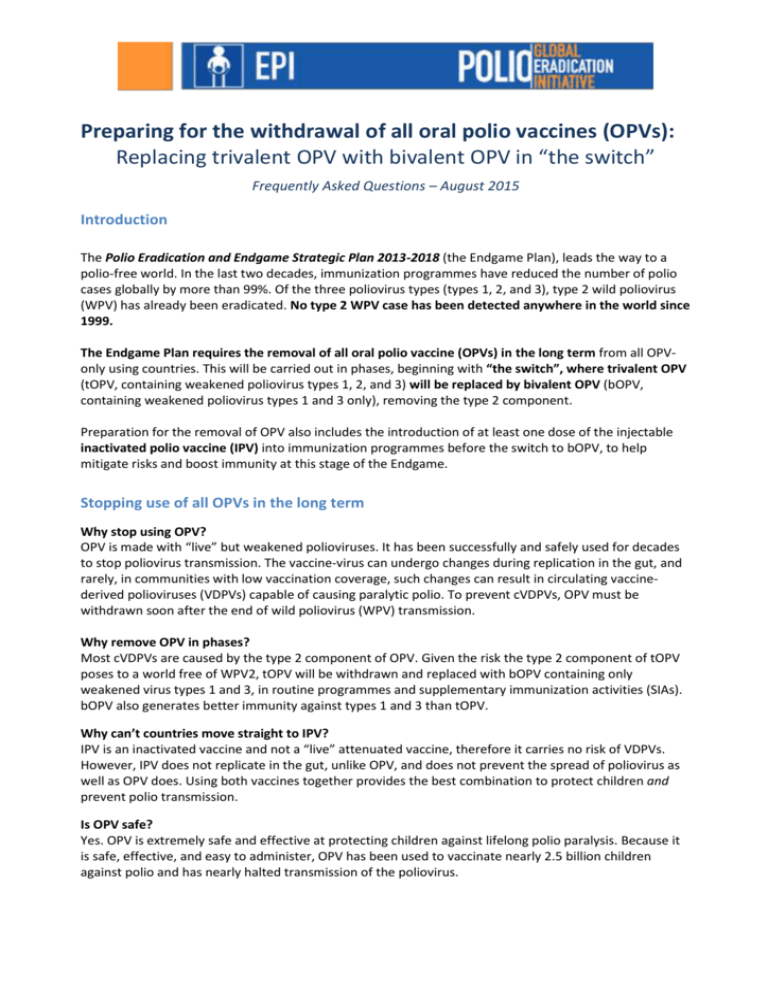
Preparing for the withdrawal of all oral polio vaccines (OPVs): Replacing trivalent OPV with bivalent OPV in “the switch” Frequently Asked Questions – August 2015 Introduction The Polio Eradication and Endgame Strategic Plan 2013-2018 (the Endgame Plan), leads the way to a polio-free world. In the last two decades, immunization programmes have reduced the number of polio cases globally by more than 99%. Of the three poliovirus types (types 1, 2, and 3), type 2 wild poliovirus (WPV) has already been eradicated. No type 2 WPV case has been detected anywhere in the world since 1999. The Endgame Plan requires the removal of all oral polio vaccine (OPVs) in the long term from all OPVonly using countries. This will be carried out in phases, beginning with “the switch”, where trivalent OPV (tOPV, containing weakened poliovirus types 1, 2, and 3) will be replaced by bivalent OPV (bOPV, containing weakened poliovirus types 1 and 3 only), removing the type 2 component. Preparation for the removal of OPV also includes the introduction of at least one dose of the injectable inactivated polio vaccine (IPV) into immunization programmes before the switch to bOPV, to help mitigate risks and boost immunity at this stage of the Endgame. Stopping use of all OPVs in the long term Why stop using OPV? OPV is made with “live” but weakened polioviruses. It has been successfully and safely used for decades to stop poliovirus transmission. The vaccine-virus can undergo changes during replication in the gut, and rarely, in communities with low vaccination coverage, such changes can result in circulating vaccinederived polioviruses (VDPVs) capable of causing paralytic polio. To prevent cVDPVs, OPV must be withdrawn soon after the end of wild poliovirus (WPV) transmission. Why remove OPV in phases? Most cVDPVs are caused by the type 2 component of OPV. Given the risk the type 2 component of tOPV poses to a world free of WPV2, tOPV will be withdrawn and replaced with bOPV containing only weakened virus types 1 and 3, in routine programmes and supplementary immunization activities (SIAs). bOPV also generates better immunity against types 1 and 3 than tOPV. Why can’t countries move straight to IPV? IPV is an inactivated vaccine and not a “live” attenuated vaccine, therefore it carries no risk of VDPVs. However, IPV does not replicate in the gut, unlike OPV, and does not prevent the spread of poliovirus as well as OPV does. Using both vaccines together provides the best combination to protect children and prevent polio transmission. Is OPV safe? Yes. OPV is extremely safe and effective at protecting children against lifelong polio paralysis. Because it is safe, effective, and easy to administer, OPV has been used to vaccinate nearly 2.5 billion children against polio and has nearly halted transmission of the poliovirus. IPV and OPV offer the best protection at this stage of polio eradication Will children still have protection from wild poliovirus type 2 after the switch to bOPV? Yes, IPV protects children against paralysis from all 3 polioviruses types. Is it safe if both OPV and IPV are given to the same child? Yes. In fact, the vaccines work together to induce a stronger immune response, especially in areas where wild poliovirus and/or VDPVs are still circulating. Many countries have used OPV and IPV sequentially in their routine schedules for decades. What if a child has already received one dose of tOPV, and will next receive bOPV. Is that safe? Yes, both types of OPV are safe vaccines and can be given to the same child at different visits. bOPV will follow the same immunization schedule as tOPV, and can safely replace tOPV mid-way through. The logistics of switching from tOPV to bOPV When will the switch take place? The switch will take place in every OPV-only using country around the world within a 2-week timeframe in April 2016, during the low season for poliovirus circulation in countries with recent polio cases. After the switch, tOPV will no longer be used anywhere in the world, and manufacturers will no longer supply tOPV (production will have stopped much sooner due to production lead times). Why does the switch need to take place globally in a two-week window in April 2016? Can a country make the switch before or after April 2016? Any use of tOPV after the switch could jeopardize polio eradication by generating type 2 cVDPVs. It is important that all countries switch from tOPV to bOPV during the same time period to ensure that no country is put at risk of importing a type 2 cVDPV from another country that continues to use tOPV. For the same reason, it is NOT recommended that countries switch before April 2016 as use of bOPV while tOPV is still being used would place the country at risk. Countries are welcome to implement the switch anywhere within the two week ‘switch window’ when it is announced. How is tOPV different to bOPV? Does it follow the same schedule? tOPV is exactly the same as bOPV, with the only difference that bOPV does not contain the type 2 virus component. All other aspects are the same; schedule, administration, and handling. How can cold stores and facilities manage the balance of tOPV, to ensure that there are no excess stocks or stock-outs? Countries should carefully monitor current tOPV stocks at all levels. WHO recommends that shortages be prevented by carefully monitoring inventories and ordering a 2-week buffer stock of tOPV vaccine prior to the switch. Collection and disposal of remaining tOPV stock What will happen to unused stocks of tOPV after the global switch to bOPV? Any use of tOPV after the switch could cause outbreaks of cVDPV2, therefore all remaining tOPV must be destroyed to prevent accidental or deliberate use. Immediately after the switch date, all remaining tOPV vials should be collected and properly disposed of as medical waste, either through incineration in highor medium-temperature incinerators, by encapsulation and disposal in a landfill site, or direct disposal in an engineered landfill site. If countries have surplus stock of tOPV after the switch date, can they first use those supplies before making the switch to bOPV? No. They must stop using tOPV on the switch date and any remaining stocks must be destroyed. Any area continuing to use tOPV after all others have switched puts neighboring communities at risk.
